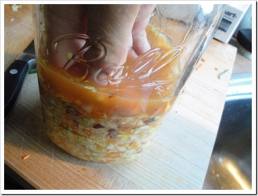
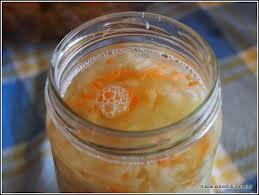
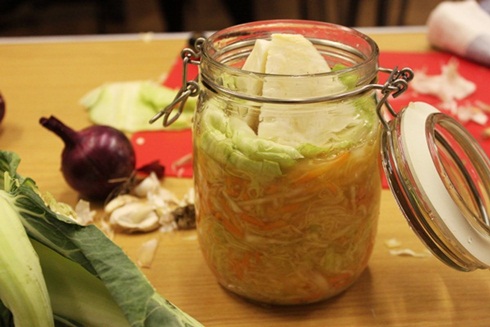
~
| HOME | Its All About The GUT! | Kombucha Tea | Water Kefir | Milk Kefir | Sprouts | KIMCHI | Sourdough |
| Fermented Veggies - Wild Ferment! | ||
 |
 |
 |
|
In a nutshell.......So,what happens in sauerkraut and how do we know
it’s safe? When shredded cabbage is mixed with salt at a ratio of roughly
2% (by weight), osmosis pulls the juice out of the vegetables, submerging
them in a salty brine. Fresh vegetables, such as cabbage, are literally
teeming with microbes both good and bad, but mostly good. Fortunately,
it’s the good guys who love the salty brine – they quickly use up the
available oxygen and the brine is then anaerobic, meaning it lacks oxygen.
That lack of oxygen prevents the bad microbes that would spoil our food
from taking hold. As the good bacteria multiply they create lactic acid,
lowering the ph of the brine so that toxic organisms cannot reproduce. The
lactic-acid bacteria thrive in this salty, acidic environment. They
consume the starches in the cabbage, creating more lactic acid, carbon
dioxide, and enzymes. Eventually they consume all the starches and their
lifecycles are complete.http://www.killerpickles.com/klassic-kraut/ |
| How Vegetable Fermentation Works © | Safety of Fermented Vegetables © |
SALT Guidelines |
| Salt calculator {off site} |
Fred Breidt,
microbiologist with the U.S. Dept. of Agriculture:
"With fermented products there is no safety concern. I can flat-out say that.
The reason is the lactic acid bacteria that carry out
the fermentation are the world's best killers of other
bacteria."
http://www.sfgate.com/food/article/Cultivating-their-fascination-with-fermentation-3295948.php
Overview of what happens during the ferment cycles... Salt, in normal water, (which is normaly PH 7.0), is used to drop the PH slightly and provide the perfect environment for the 1st stage bacteria in the fermentation process to proceed and grow very well, and do their initial critical toxin disassembly, and other unlocking proceedures within the plant material. It is all a very natural progression designed into nature. The best reason for using salt brine is the natural cycle of fermentation . Ideally what happens in a salt... (saline brine solution) is that it provides the correct environment for the first stage bacteria to flourish, instead of harmful ones... Mostly, it is a PH thing that determines safe fermentation. All things ferment, it is whether the ferment is on safe or unsafe terms is all. (Even a deadly or bad bacteria ferment is still fermentation...how we control it determines the end product).- Lance Hancherow
“New” function of your stomach
http://articles.mercola.com/sites/articles/archive/2013/06/01/fermented-vegetables.aspx
A rediscovered study from 1948 may reveal an amazing “new” function of your stomach: filtering out pathogenic microbes before they can pass through to your intestinal tract. As you age, your healthy gut flora diminishes and your stomach becomes less acidic, which may set you up for gastrointestinal dysbiosis and a number of serious health problems that follow from it, including dementia. Beneficial gut bacteria play important roles in vitamin production, mineral absorption, detoxification, and helping prevent diabetes, digestive issues, neurological problems, cardiovascular disease, and even acne.
Your microbiota also plays a large role in your metabolism; sugar, refined carbohydrates and junk foods cause certain bacteria to release endotoxins, which drive inflammation and cause metabolic changes that result in overproduction of insulin, increased appetite, increased fat storage and obesity
One of the best ways to protect your health is by keeping your gut flora healthy with naturally fermented foods; one-quarter to one-half cup of fermented veggies with each meal is ideal, but you may need to work up to this gradually; instructions are given for how to make your own naturally fermented vegetables at home with just a few simple tools
Fermented Mixed Veggies
Recipe Notes: You may add herbs and spices to taste based on personal preference. Cilantro, hot peppers, oregano etc...
1 large cabbage, cored and shredded (keep one large leaf aside for use as a "lid"**)
1-2 cup carrots, grated
2 english cucumbers sliced (wash but do not peel)
2 medium onions, quartered lengthwise and very finely sliced
1 bunch dill chopped
3 tbsp salt per 5 pounds of veggies
In a large bowl mix all veggies and sea salt Pound with a wooden pounder or a meat hammer for about 10 minutes to release juices.
Place in 3 quart-sized, wide mouth mason jars and press down firmly with a pounder or meat hammer until juices come to the top of the cabbage. Take the leaf of cabbage** and fold it so it fits snugly over the top of the vegetable mixture. The top of the cabbage leaf should be at least 1 inch below the top of the jars.
Cover with cheese cloth and place in a pan (because juices may run over during the week). Keep at room temperature for about 7 days before transferring to cold storage.
Check each day to make sure the liquid remains above the vegetable mixture.
You may weigh down the mixture with a glass placed onto the vegetables but underneath the cheese cloth.
This will make enough to fill up to three quart jars.
To read more about the process of fermentation refer to the following website for easy to understand information
http://www.wildfermentation.com/vegetable-fermentation-further-simplified-2/
~
 Many more pictures on our product line website
Many more pictures on our product line website |
|
~
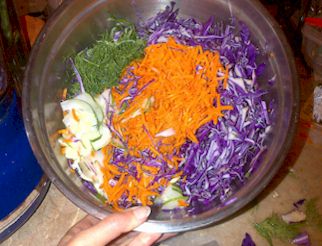 |
 |
| Chop-Chop | Smash-Smash |
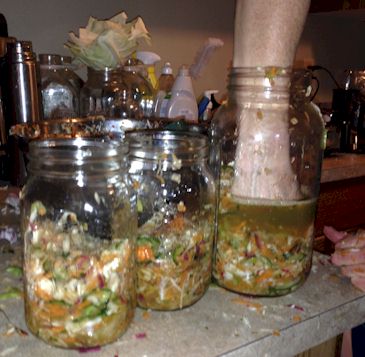 |
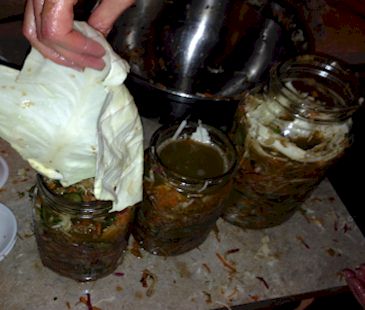 |
| Smush-Smush | Cabbage Cap |
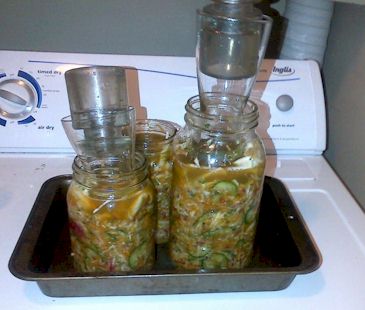 |
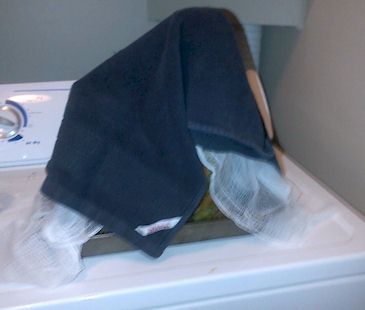 |
| Drown | and cover. |
~
or....if you have access to a food processor:
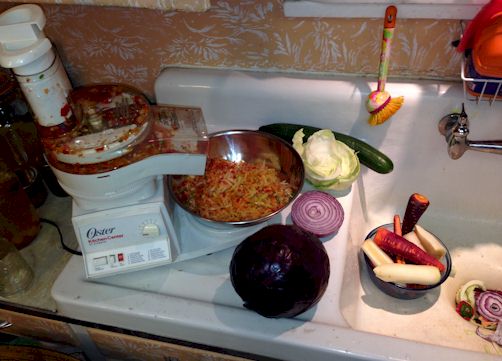 |
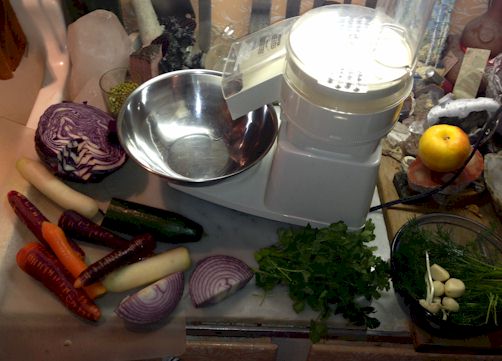 |
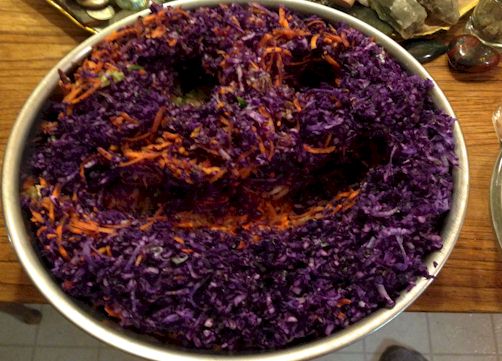 |
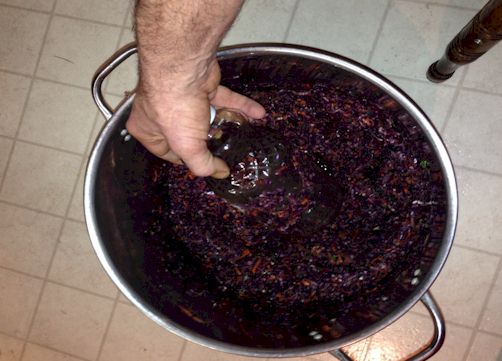 |
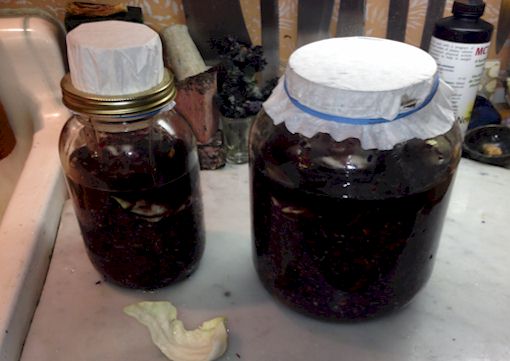 |
Top left pic shows a nicely cleaned food processor-ready to get messy AGAIN because I decided to throw it all my leftover vegies (and more importantly the forgotten sprouted garlic/cilantro & dill) into the batch. When cooking playing with food is mandatory, this case smashing the veggies with a glass jar helps to release the juices. The pic to the left shows smaller jars used to press the cabbage leaf "hat" that helps hold the mass under the juice. The coffee filters allow breathing and prevent bugs/dust contamination. |
Fermenting and mold tips:
I highly recommend the book "Wild Fermentation" by Sandor Ellix Katz
http://www.domesticdiva.ca/wp-content/uploads/2011/11/Got-Slimy-Ferments.pdf
4 Reasons your cultured veggies might turn slimy:
1) Not enough salt (salt inhibits the bacteria strains that we don`t want from predominating).
2) One of the bacteria`s that cultures veggies is a slime producing one, the veggie's indigeous bacteria undergoes a natural succession: first coliform bacteria are favored, then the slimy Leuconostoc are favored, and finally the lactic acid bacteria such as Lactobacilli predominate and essentially eliminate the coliforms and Leuconostoc.
3) There are some strains in whey that can make slime too. 4) Lb. planterum can also make kraut slimy.
Here are your choices when you get one of those rare slimy ferments:
1) The best thing to do with slimy ferments is put it back in the fridge and let it ferment for a few more weeks and see if the slime is gone. Over time, some people have found that as the lactic acid bacteria predominate, the slime goes away.
2) Others just rinse the slime off the veggies (your ferment is not considered bad from a microbial standpoint).
Here is what to do to prevent slimy ferments:
1) If you want to use less salt, maybe next time put a little lemon juice or unpasteurized apple cider vinegar in there to prevent the slime promoting bacteria from predominating when you use less salt. Try the juice of half a lemon or 2 Tbsp of unpasteurized apple cider vinegar. The strains of bacteria that we really want, thrive in that acid medium (lactic acid fermentation). ~~
~
| HOME | Its All About The GUT! | Kombucha Tea | Water Kefir | Milk Kefir | Sprouts | KIMCHI |
How Vegetable Fermentation Works ©
By
Sarah Nelson Miller on
Sunday,
June 16, 2013 at 1:29pm
Please do not
edit this document without the permission of the Wild Fermentation Admins.
PRINCIPLES OF
LACTIC ACID FERMENTATION
© Wild Fermentation Facebook Group
Lactic acid
fermentation is a consistent and well-documented process observed by scientists
who have studied sauerkraut, kimchi, and other traditionally fermented
vegetables.
IN ORDER TO GROW,
BACTERIA NEED: FOOD, WARMTH, WATER, AND TIME.
·
Food:
Fermentation is a process that converts glucose into lactic acid (and ethanol
and carbon dioxide, in lesser amounts).
·
Temperature: The
bacteria involved function best at a temperature range of 59* to 72*F.
·
Water: Bacteria
require moisture to reproduce. Low-moisture foods are preserved because the
bacteria contained in them are unable to replicate.
·
Time: Lactic acid
fermentation of vegetables is a process that proceeds through several stages of
bacterial growth (detailed below). How much time it takes depends on how much
food there is for the bacteria to eat (vegetables fermented in their own juices
have more glucose than those in a salt-water brine) and how warm it is (warmer
temperatures speed up the process). Generally speaking, it is a process that
takes
, not days.
·
Salt: lactic acid
bacteria are generally quite tolerant of salt, which enables them to thrive in a
salty brine while less desirable bacteria perish. Additionally, salt neutralizes
the pectinase enzyme which can make vegetables mushy.
Overview of
Fermentation
Vegetables should be submerged in a salty brine - between 1% and 3% salinity.
Soil-based organisms will quickly use up the oxygen, creating an anaerobic
environment. They excrete lactic acid, which preserves the fermented vegetables
and gives them their distinctive, tangy flavor. Fermentation is initiated by Leuconostoc mesenteroides. They will raise acidity
to 0.3%, which is their threshold so they begin to die. Lactobacillus plantarum take over next, and raise the acidity to 2%, at which
point they begin to wane.
Lactobacillus brevis works in the final stage, raising acidity to about 2.5%.
The ph will be about 3.4 at completion. At this point the ferment is
well-preserved and can be stored in a cool place for many months without
spoiling.
Although those
are the primary lactic acid bacteria responsible for vegetable fermentation,
there are many other microbes present, including yeasts (which produce alcohol)
and acetobacter (which produce acetic acid).
Temps above 72*F, salinity above 3%, and acidity above 0.3% will inhibit L.
mesenteroides, bypassing the first stage of fermentation. Tests done under these
conditions created sauerkraut that was described as being "poor, unbalanced, and
less complex" due to the lack of different metabolites.
Sources: The Handbook of Functional Fermented Foods, and the Food and
Agriculture Organization's Fermented Fruits and Vegetables handbook: http://www.fao.org/docrep/x0560e/x0560e00.htm
*This original document is the property of the Wild Fermentation Facebook
Group.*
| HOME | Its All About The GUT! | Kombucha Tea | Water Kefir | Milk Kefir | Sprouts | KIMCHI |
Safety of Fermented Vegetables ©
By
Sarah Nelson Miller on
Sunday,
August 31, 2014 at 1:33pm
Examining the
Safety and Risks of Fermented Vegetables
© Wild Fermentation Facebook Group
Food can be
contaminated with pathogens which are not detectable by sight, odor, or taste.
The pathogens responsible for food-borne illnesses that may be present on
vegetables are:
·
Clostridium
botulinum
·
Listeria
monocytogenes
·
Salmonella
enterica
·
Escherichia coli
All of these
microbes are widespread in the environment and some also inhabit the
gastrointestinal tracts of humans and other mammals. Any food in its raw state
may be a carrier of these bacteria, and C. botulinum and L. monocytogenes
particularly are associated with raw vegetables as they are soil-based
organisms. Washing generally removes these organisms. Cooking will often
neutralize them. Another method for rendering raw food safe is fermentation.
Vegetable fermentation results in the production of organic acids. Finished
sauerkraut has a ph of 3.4. Organic acids neutralize food-borne pathogens
by disrupting their reproductive cycle. All of the pathogens listed above (and
many others) require a neutral ph to reproduce. The minimum ph for reproductive
activity of these pathogens is: C. botulinum - 4.6; L. monocytogenes - 4.3; S.
enterica - 6.5; E. coli - 4.4. However, this is the minimum ph under ideal
conditions. The conditions in fermented vegetables are decidedly less than
ideal due to the presence of lactobacillus bacteria and lactic acid. Scientists
have found that different kinds of organic acids have different impacts of
food-borne pathogens, and lactic acid is more inhibitory than other acids,
including hydrochloric acid. This means that sauerkraut and pickles are more
toxic to pathogens than our own stomachs.
Lactobacillus bacteria, particularly Lb. plantarum (one of the primary agents in
vegetable fermentation) produce bacteriocins, which are toxins that inhibit
competing bacteria. They have also been found to inhibit pathogenic bacteria.
Bacteriocins, and the bacteria that produce them, are considered to be
"bio-preservatives" of food by preventing spoilage and contamination.
Finally, please consider this quote from Fred Breidt, microbiologist with the
U.S. Dept. of Agriculture:
"With fermented products there is no safety concern. I can flat-out say that.
The reason is the lactic acid bacteria that carry out the fermentation are the
world's best killers of other bacteria." http://www.sfgate.com/food/article/Cultivating-their-fascination-with-fermentation-3295948.php
And watch this video by Sandor Katz: https://www.youtube.com/watch?v=9QdhSFfaoz0
Spoilage
Spoilage is detectable deterioration which renders food inedible. It is caused
by enzymes, oxidation, and microorganisms, especially mold. Food that is spoiled
has a foul odor and appearance. Fermentation protects against spoilage in a
number of ways:
Enzymes are inhibited both by salt and by lactic acid. If insufficient
salt is used, a ferment may become mushy.
Oxidation (browning) is prevented by submerging vegetables in brine. It
may occur if food is not kept under the brine. Oxidation is harmless (like brown
apples) but undesirable. Remove oxidized portions before eating the rest.
Microorganisms are inhibited by the presence of lactic acid and the lack
of oxygen.
Vegetables fermented in an open container may be subject to surface growths, or
scum. A white, powdery or thready growth is known colloquially as "kahm yeast"
and is harmless. It is an overgrowth of an undesirable bacteria or yeast. It
should be skimmed off so as not to affect the flavor of the ferment. In brewing,
this growth is known as a "pellicle."
Mold will present itself as a furry or fuzzy growth, often forming spores which
are black, green, or blue. It will have a musty odor. Mold can send invisible
tendrils down into soft foods. Some molds are able to produce mycotoxins, which
cause illness. The USDA recommends discarding any soft food that is contaminated
with mold.
Surface growths such and kahm yeast and mold require oxygen to occur. They can
be prevented by covering your ferment with a lid to exclude oxygen. If you are
unsure what you are seeing on a ferment, these photos may help: https://www.facebook.com/media/set/?set=oa.10151113022015369&type=1
*nformation in this file is applicable to vegetable fermentation only.
Fermentation of meats and cheeses require other safety considerations.
Further Reading
Wild Fermentation & Art of Fermentation, by Sandor Katz
The Handbook of Functional Fermented Foods
Food and Agriculture Organization's Fermented Fruits and Vegetables handbook: http://www.fao.org/docrep/x0560e/x0560e00.htm
Role of Biopreservation in Food Safety and Storage: http://www.ijera.com/papers/Vol4_issue1/Version%203/D41032632.pdf
USDA page on molds:
http://www.fsis.usda.gov/wps/portal/fsis/topics/food-safety-education/get-answers/food-safety-fact-sheets/safe-food-handling/molds-on-food-are-they-dangerous_/
Botulism: http://www.fda.gov/food/foodborneillnesscontaminants/causesofillnessbadbugbook/ucm070000.htm
Listeria: http://www.foodsafetywatch.org/factsheets/listeria/
Salmonella: http://www.foodsafetywatch.org/factsheets/salmonella/
E. coli: http://www.foodsafetywatch.org/factsheets/escherichia-coli/
*This original document is the property of the Wild Fermentation Facebook
Group.*
HOME
Its All About The GUT!
Kombucha
Tea
Water
Kefir
Milk
Kefir
Sprouts
KIMCHI
SALT Guidelines ©
By
Sarah Nelson Miller on
Thursday,
January 3, 2013 at 1:48pm
© Wild
Fermentation Facebook Group
Salt's Purpose
Salt serves a useful function in fermenting vegetables, beyond the flavor it
contributes. Salt helps to harden the pectins in vegetables. Fresh produce
carries enzymes that decompose and soften them; salt helps to neutralize this
enzyme. Salt also works by exclusion, preventing spoilage organisms from
becoming dominant. With no salt very few organisms are excluded. As salt levels
are increased more organisms are excluded. At very high levels of salt, no
organisms can reproduce. Best results are achieved when one uses enough salt to
disable enzymes and exclude spoilage organisms, but not so much that good lactic
acid bacteria won't function.
Types of Salt
A natural salt is
the best choice for fermenting. If using a refined salt, choose one that is pure
sodium chloride and does not contain any anti-caking agents or iodine. Salts
with these additives can make the brine turn cloudy and leave sediment at the
bottom, or cause a darkening or discoloration of the vegetables.
Unrefined salts
with all their minerals intact are recommended because trace minerals facilitate
the enzymatic processes which occur in fermentation. Unrefined salts are usually
light pink or gray in color. Popular choices are sea salts, Himalayan Pink,
Celtic Grey, and Redmond Real Salt.
Salt Grind
Recipes are usually written for fine grind table salt. There is a slight
variation in the density of various brands of salt, so that 1 tablespoon of one
kind might weigh slightly more than 1 tablespoon of another, but not enough to
have marked impact on the percent of salt in the final product. Kosher grind
salt can be used in place of fine grind, with no adjustments. Salt can be
weighed on a scale if precision measurements are desired.
Mixing a Salt
Brine:
Vegetables can be fermented in brines from 1.5% to 5%. There are several bacteria that work together to ferment vegetables and they all have a different optimum salinity. A brine of 2% to 3% will tend to achieve the best flavor profile. Brines higher than 5% will curtail bacterial activity.
Cucumber pickles
should be fermented in a brine of 3.5% for half-sours or 5% for full-sours.
Below are
instructions for mixing brines. I weighed Real Salt brand fine grind (table
salt) to get these measurements. Measure salt and stir into cool water until
dissolved.
For 1 quart of
water
·
2% = 19g or 1
tablespoon
·
2.5% = 24g or 1
tablespoon + 1 teaspoon
·
3.5% = 33g or 2
tablespoons
· 5% = 48g or 3 tablespoons
Dry-Salting
Vegetables:
Dry-salting means
you mix salt with sliced or grated vegetables to draw liquid out so they create
their own brine. This is the method used for sauerkraut and sauerruben. Measure
salt as a percentage of the weight of the vegetables. Again, a range of salinity
will work but best flavor will be achieved at about 2%. I also used Real Salt
fine grind to calculate these measurements.
Vegetables
(pounds) to salt (grams)
· 1/2# : 5g or 1 teaspoon
·
1# : 9g or 2
teaspoons
·
2# : 18g or 1
scant tablespoon
·
2.5# : 23g or 1
rounded tablespoon
·
3# : 27g or 1
tablespoon + 2 teaspoons
·
3.5# : 32g or 2
scant tablespoons
·
4# : 36g or 2
tablespoons
·
5# : 45g or 3
tablespoons
·
10# : 91g or 5
tablespoons
Lower Sodium
Ferments
It is possible to ferment without salt, but there is
more risk of spoilage, the vegetables may get mushy, and the shelf life will be
shortened. Proper salinity helps keep vegetables crisp and encourages the growth
of beneficial bacteria. If you choose a natural, unrefined salt you will also be
providing the lactic acid bacteria and yourself with necessary trace minerals.
For a no-salt ferment, use of spices such as caraway, coriander, ginger, garlic,
or fennel is recommended as they will aid in exclusion of spoilage organisms.
Please note that although there are "no-salt" recipes that call for celery
juice, celery is naturally high in both sodium and nitrates, so this may not be
the low sodium alternative one seeks.
Good results can
be achieve with 1% salinity in a kraut or 1.5% salinity in a brine. If seeking
to reduce sodium as much as possible it is important to purchase a good digital
scale with tare function. To make a lower sodium dry-salted ferment, such as a
kraut, trim the vegetables, chop, and weigh them. Then weigh the salt at a ratio
of 1% the weight of the vegetables. To make a 1.5% brine, add 15g salt to 1
liter of water.
It's not
necessary to use any kind of starter in low sodium ferments, but one can add a
small amount of vinegar (about 2tsp per quart) to disable the enzymes and deter
spoilage organisms.
Further Reading
Wild Fermentation & The Art of Fermentation, by Sandor Katz
The Permaculture Book of Ferment and Human Nutrition, by Bill Mollison
http://www.foodproductdesign.com/Articles/2004/01/Worth-Its-Salt.aspx
http://extension.psu.edu/food/preservation/news/2012/types-of-salt-and-salt-substitutes-in-canning
*This original document is the property of the Wild Fermentation Facebook
Group.*
PLASTIC VS GLASS
Since ferments are known to have the ability to detox, I’m especially concerned about the potential for ferments to pull toxins into the brine. Estrogenic disruptors have been found to leach from almost all plastics. Therefore, I will only allow glass, clay, or wood to touch all of my fermented foods. In addition, acid has an effect on the leeching rate of plastics. Many articles telling you not to put acidic liquids into a plastic container because BPA would leech into them. It stands to reason that if BPA would leech with acid, it’s quite possible that other bisphenol compounds would, too. Ferments are acidic, so I don’t want them anywhere near any plastic until we know more about the leeching issue. All kinds of magic happen on micro chemical, electrical, and biological, levels.... why put plastic into the mix? http://www.ncbi.nlm.nih.gov/pmc/articles/PMC3222987/
HOME
Its All About The GUT!
Kombucha
Tea
Water
Kefir
Milk
Kefir
Sprouts
KIMCHI
FERMENTATION LINKS - and other related stuff
#
| HOME | Its All About The GUT! | Kombucha Tea | Water Kefir | Milk Kefir | Sprouts | KIMCHI |